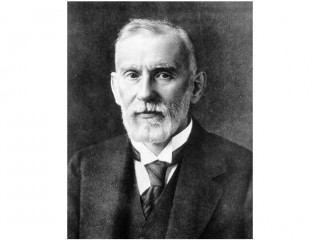
Paul Ehrlich biography
Date of birth : 1854-03-14
Date of death : 1915-08-20
Birthplace : Strzelin, Poland
Nationality : German
Category : Science and Technology
Last modified : 2011-12-21
Credited as : scientist, Father of chemotherapy, Nobel laureate
0 votes so far
Paul Ehrlich was a pioneer in the fields of chemotherapy (treatment of disease with chemical agents) and hematology (the study of blood). He was born in Strehlen, Germany (now Strzelin, Poland), worked for several years under under Robert Koch, and shared the 1908 Nobel Prize for Physiology or Medicine with Ilya Mechnikov. He worked with Emil von Behring to develop a diphtheria antitoxin, released in 1892, and worked with Sahachiro Hata (1873-1938) to develop salversan, an arsenic derivative that proved the first effective treatment for syphilis, and was introduced in 1910.
Ehrlich was among the first researchers to explore dye reactions on red and white blood cells, determining which types of tissue are susceptible to particular chemicals and dyes. He established several fundamental principles of immunology, and spent much of his career searching for new synthetic compounds that might attack microorganisms that carried specific diseases. He also developed the Side-Chain Theory (Seitenkettentheorie) in 1897, proposing that animal cells and bacteria act like dye, with complex molecules reacting with each another through side chains when these side chains have corresponding structure.
He was a cousin and close friend of German pathologist Karl Weigert (1845-1904), and his daughter married mathematician Edmund Landau (1877-1938). In Dr. Ehrlich's Magic Bullet, a 1940 Hollywood movie that dramatized the search for a cure for syphilis, Ehrlich was played by Edward G. Robinson. He was not related to ecologist Paul R. Ehrlich.
The concept of a "magic bullet" drug comes from the experience of 19th century German chemists with selectively staining tissues for histological examination, and in particular, selectively staining bacteria (Ehrlich was an exceptionally gifted histological chemist, and invented the precursor technique to Gram staining bacteria). Ehrlich reasoned that if a compound could be made that selectively targeted a disease-causing organism, then a toxin for that organism could be delivered along with the agent of selectivity. Hence, a "magic bullet" would be created that killed only the organism targeted.
A problem with the use of the magic bullet concept as it emerged from its histological roots is that people confused the dye with the agent of tissue selectivity and antibiotic activity. Prontosil, a sulfa drug whose active component is sulfanilamide, is a classic example of the fact that color is not essential to antibacterial activity.
The concept of a "magic bullet" was fully realized with the invention of monoclonal antibodies.
Paul Ehrlich's life and achievements were filmed 1940 in Hollywood by William Dieterle in Dr. Ehrlich’s Magic Bullet with Edward G. Robinson in the title role.
The German Federal Institute for Vaccines and Biomedicines (Paul-Ehrlich-Institut, abbreviated PEI) is named after Paul Ehrlich.
Author of books:
-Das Sauerstoff-Bedürfniss des Organismus (1885, medicine)
-The Collected Papers of Paul Ehrlich (1960, three volumes; posthumous)
















